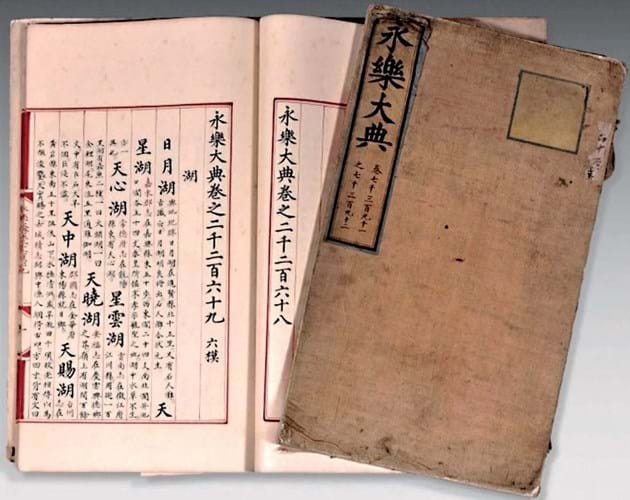
Estimated at €5000-7000, they sold for a massive €6.4m (£5.82m) or €8.13m once the 27% buyer’s premium was added.
Completed at the behest of the third Ming emperor, the Yongle Dadian (or Great Canon of Yongle) remained the largest encyclopedia in the world until the growth of Wikipedia in 2007.
Gathering knowledge from 8000 historic texts, some 2169 scholars worked on the project that by 1408 counted 22,877 juan (chapters) arranged across 11,095 yellow silk-bound volumes. The handwritten text assumed a novel ordering system that arranged the contents by phonics rather than by subject matter.
Today the contents of fewer than 400 volumes of the Dadian (around 3%) are known. The original 15th century manuscript did not survive the fall of the Ming while a copy commissioned by the Jiajing emperor between 1562-67 was largely burned or looted during the Second Opium War and the Boxer Rebellion.
It is a source of national chagrin that China holds just 221 volumes of its greatest literary work, with others residing in Taipei (61 in the National Palace Museum), Europe (51 in various libraries in the UK and five in Germany) and the US (47).
These include discoveries made in recent decades, including single volumes found in the Huntingdon Library in California in 2014 and the University of Aberdeen (1997). In 2009 China’s National Administration of Cultural Heritage allocated a special fund to buy a volume from a Canadian- Chinese collector.
‘Gift to ancestor’
The two volumes offered for sale at Beaussant Lefèvre’s Art of Asia sale on July 7 in the Drouot auction centre came for sale without a published provenance – although it is understood they had been a gift to the vendor’s ancestor, who worked in China in the 19th century.
They were numbered 2268-2269 (chapters dedicated to the geography of the lakes of China) and 7391-7392 (describing funeral rites). Remarkably, one of the 24 volumes in the British Library collection (chapters 7389-7390) immediately proceeds the latter. It was presented in 1938 by Clau Cecil Augustus Kirke (1875-1959), a soldier and diplomat who spent much of his career in China.
Despite the modest estimate, Beaussant Lefèvre (and Paris Asian art specialist Cabinet Portier, which provided the cataloguing) expected serious interest.
No internet bids were permitted for the lot with all phone and room bidders subject to a pre-agreed deposit of €20,000.
Around a dozen prospective buyers provided the competition, with the winning bidder described as a private rather than an institutional buyer.














